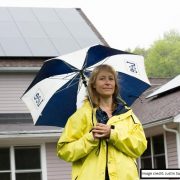By Carolyn Lochhead and David R. Baker
WASHINGTON — President Trump’s decision to abandon the Paris Accord will slow the battle against climate change in the U.S., but there’s too much momentum in the nation’s clean-energy economy to shut it down, energy experts say.
Trump’s move on Thursday sent a “shock wave” through the renewable energy sector, said Mark Bauhaus, a partner at Just Business, a San Francisco tech incubator. But the business opportunity in the so-called decarbonization of the economy is “bigger than the Internet,” he said.
“We have to remake the economy for low-carbon, clean energy, efficient everything: transportation, agriculture, appliances, houses, generation, all the grids,” Bauhous said. “The fact that the federal government is going backwards doesn’t change that inexorable momentum.”
Two broad trends have driven the country’s growing reliance on renewable energy. One is the plummeting cost of solar and wind power, now cheaper in many circumstances than electricity from plants that burn fossil fuels. The other is the increasingly visible evidence that damage from a warming climate will bear an enormous cost.
The combination, analysts say, is driving city and state governments, businesses and individuals alike to embrace the new forms of energy, even in deep-red states.
The city of Carmel — not the California coastal enclave, but a Republican-dominated town in Indiana — has committed the community to 100 percent renewable energy in 20 years, Mayor Jim Brainard said in a conference call Friday. The plan began long before the Paris Accord.
Carmel is changing its design, from installing walking and biking trails to adding hundreds of traffic roundabouts that each save 25,000 gallons of fuel a year, Brainard said. And the city is replacing its streetlights with energy-efficient LEDs.
“Other cities are going to do the same thing,” he said. “Those forces are far stronger and make a lot more difference than the president’s proclamation.”
California Gov. Jerry Brown, a Democrat, may have seemed to be on a quixotic tangent when in 2015 he linked up with the German city of Baden-Württemberg to found the Under 2 Coalition, an organization of states, regions and cities that have pledge to reduce their greenhouse gas emissions to net-zero by 2050.
Currently in China to expand the Under 2 Coalition, Brown has gained the national spotlight as Trump’s chief climate antagonist. On Thursday, he countered Trump’s announcement by forming a new coalition with the governors of Washington and New York to try to meet the goal American negotiators agreed to in Paris in 2015 — to cut nationwide emissions at least 26 percent below 2005 levels by 2025.
Former New York Mayor Michael Bloomberg followed Brown’s path on Friday, forging yet another coalition of cities, states and businesses to try to meet the U.S. targets. So far, 30 mayors, three governors and more than 80 university presidents and over 100 businesses have signed on.
Last month, Atlanta officials committed to operating on 100 percent renewable energy, joining 27 other cities.
Twenty-nine states now have standards for increasing their use of renewable power. California gets more than 27 percent of its electricity from renewable sources, and state law requires 50 percent by 2030.
States can also set energy-efficiency standards for buildings and adopt policies encouraging the use of lower-carbon fuels. They can help fund mass transit, while local governments can shape land-use policies to build more housing near transit or job centers in an effort to cut commutes.
They can even try tackling greenhouse gas emissions directly through a cap-and-trade system or a tax on carbon emissions, although no state has adopted a carbon tax. California has a cap-and-trade system that covers most of the economy, while nine northeastern states use cap and trade to limit emissions from power plants.
“You’re talking about a long list here of important policies that aren’t federal,” said Mark Muro, senior fellow with the Brookings Institution. “We’ve somewhat underestimated that set of potential actions. And like it or not, the nation is now going to have to see how much we can leverage from bottom-up activity.”
But some analysts say, as meaningful as the efforts are, they probably won’t be enough to make up for the goal set down in Paris.
“Without re-engagement at the federal level, presumably starting in 2021, that target will be hard to meet, even with ambitious actions at the state and local levels,” said Kevin Kennedy, deputy director of the U.S. Climate Initiative at the World Resources Institute think tank.
If anything, though, the decision to withdraw from the Paris Accord may have provided a heightened incentive to move forward, said Andrew Beebe, managing director of Obvious Ventures, a venture capital firm in San Francisco that focuses on businesses that operate on environmental and social problems.
“Businesses feel a sense of greater vigilance and need to step in and make these things happen, but they were already there,” Beebe said. “Utility executives are not going to suddenly say, ‘Let’s start building coal plants.’ They build on 20-year horizons, and this presidency has another seven years at most.”
Other major factors that will keep driving the change to renewable energy are the plummeting price of solar and wind power across the country — a recent study from financial advisory firm Lazard found both to be cheaper in most circumstances than new coal-fired generation — and lifestyle benefits associated with it.
“People are not stupid. They see that it’s much cheaper and much healthier and much better for their kids’ survival to go to clean renewable energy,” said Mark Jacobson, a professor of environmental engineering at Stanford University.
A less recognized force propelling many people to reduce emissions is the “increasing obviousness of the damage” from climate change, and the costs of adapting to it, said John Holdren, who served as President Barack Obama’s science adviser.
“All around the world, we’re seeing increases in torrential downpours and associated flooding directly attributable to climate change,” Holdren said. “We are seeing increases in the intensity and length of heat waves. We’re seeing in drought-prone regions increases in drought.
“We’re seeing increases in the annual area burned by wildfires,” he continued. “We’re seeing thawing in the permafrost and the release of additional greenhouse gases. We’re seeing the disappearance of mountain glaciers, coastal glaciers and the great ice sheets on Greenland and Antarctica, losing ice at an increasing pace, raising sea level, with resulting increasing damages and nuisance flooding on almost every high tide in low-lying places.”
Trump’s decision “will have an adverse impact,” Holdren said, “but it can be partly alleviated by what states, cities, individuals, businesses and civil society decide to do.”
California’s aggressive climate change efforts, now more than 10 years old, have produced results. But progress has taken time.
The state’s greenhouse gas emissions peaked in 2004, at 487.6 million metric tons. By 2014, the most recent year for which data are available, emissions had fallen 9.5 percent. The historic drought, which slashed the output of California’s hydroelectric dams, didn’t help. Neither did the surprise closure in 2012 of the San Onofre nuclear plant.
And while California produces fewer greenhouse gases per person than does the country as a whole, the state’s 2014 per capita emissions of 11.4 tonsremain well above those of China (7.6 tons per person), India (1.8 tons) and the European Union (6.7 tons).
“Our policies are just now beginning to ramp up and reduce carbon across our economy,” said Laura Wisland, a senior energy analyst at the Union of Concerned Scientists. “If we continue to stay that course, we will begin to see very dramatic reductions in carbon in the coming years.”
Ali Zaidi, Obama’s former energy adviser, now at the Morrison Foerster law firm and a scholar at Stanford University, said the economics of clean energy are now “hardwired” to the point where it will continue penetrating the economy. The only question is how fast and “who’s going to lead us getting there.”
As Trump proposes slashing climate spending, China has announced a $360 billion investment in renewable energy.
“If we’re not innovating the next generation of (photovoltaic) cells and modules in the United States,” Zaidi said, “there’s no question about where those jobs are going to expand.”
Carolyn Lochhead and David Baker are San Francisco Chronicle staff writers. Email: clochhead@sfchronicle.com, dbaker@sfchronicle.com Twitter: @carolynlochhead, @DavidBakerSF




